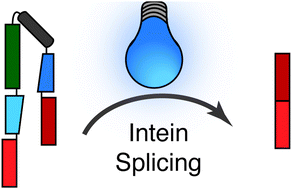Post-translational control of protein function with light using a LOV-intein fusion protein†
Abstract
Methods for the post-translational control of protein function with light hold much value as tools in cell biology. To this end, we report a fusion protein that consists of DnaE split-inteins, flanking the light sensitive LOV2 domain of Avena sativa. The resulting chimera combines the activities of these two unrelated proteins to enable controlled formation of a functional protein via upregulation of intein splicing with blue light in bacterial and human cells.

- This article is part of the themed collection: Chemical Biology in Molecular BioSystems

 Please wait while we load your content...
Please wait while we load your content...